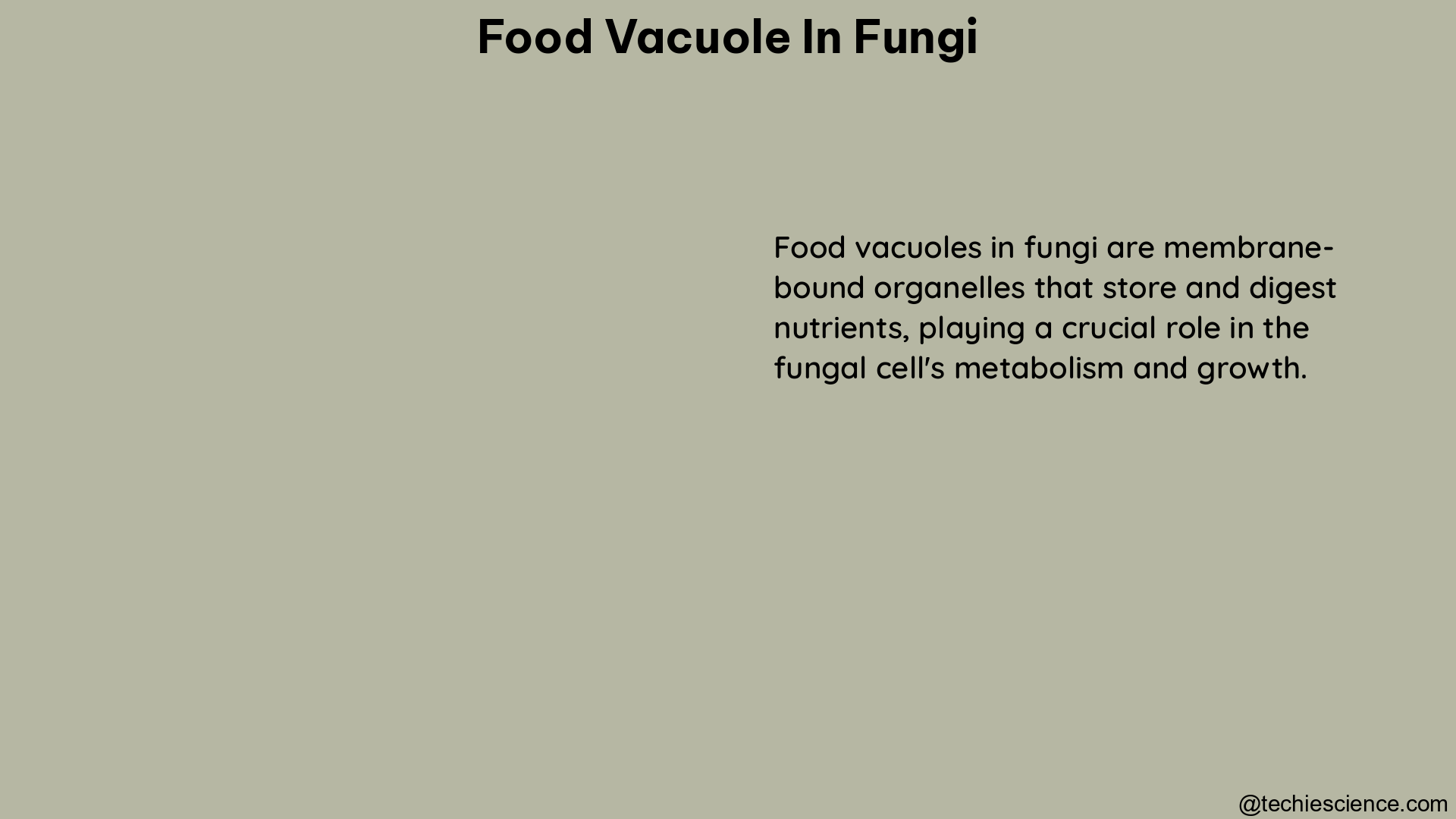The food vacuole in fungi is a membrane-bound organelle that plays a crucial role in the digestion and processing of food particles ingested by the cell. These specialized compartments serve as the primary site for the breakdown and assimilation of nutrients, enabling fungi to thrive in diverse environments and fulfill their essential metabolic functions.
Understanding the Formation and Function of Food Vacuoles in Fungi
Food vacuoles in fungi are formed when the plasma membrane of the cell invaginates, or bends inward, to engulf a food particle. This process, known as phagocytosis, traps the particle within a membrane-bound vesicle, effectively isolating it from the rest of the cell. Once the food vacuole is formed, it fuses with lysosomes, which are organelles containing a variety of digestive enzymes.
The enzymes released by the lysosomes break down the food particles into smaller, more readily usable molecules, such as amino acids, sugars, and lipids. This process of intracellular digestion allows the fungal cell to extract the necessary nutrients and energy from the ingested material, supporting its growth, development, and overall metabolic activities.
Quantifying the Role of Food Vacuoles in Antifungal Susceptibility

Researchers have employed various experimental methods to quantify the role of food vacuoles in the susceptibility of fungi to antifungal agents. One study, for example, utilized a dose-response protocol to assess the effects of different drugs, including NPD827, doxycycline, and edelfosine, on the growth of fungal cells.
In this study, the researchers set up two-fold serial dilutions of the drugs in a final volume of 40 µL and performed checkerboard assays, with NPD827 dilutions along the y-axis and other drug dilutions along the x-axis. The cell densities of overnight cultures were determined, and dilutions were prepared to inoculate approximately 10^3 cells into each well. The plates were then incubated in the dark at 30°C for 24-48 hours, and the absorbance at 600 nm was measured using a spectrophotometer. The growth of the fungal cells was normalized to the no-drug treatment well for the relevant strain.
The results of this study provided valuable insights into the role of food vacuoles in the antifungal susceptibility of fungi. By quantifying the growth of fungal cells in the presence of different drugs, the researchers were able to identify the specific effects of these compounds on the function and integrity of the food vacuoles, which are crucial for the survival and proliferation of fungal organisms.
Utilizing Fungal Spores in Sediments to Infer Past Herbivore Presence
Another fascinating application of the study of food vacuoles in fungi involves the use of fungal spores preserved in sediments to infer the presence of herbivores in the past. Certain fungi, known as coprophilous fungi, thrive on the dung of herbivores and can leave behind distinctive spores in the sedimentary record.
A study in this area found that the abundance and diversity of these coprophilous fungal spores can provide valuable insights into the past populations and habitats of herbivores. The researchers used a comprehensive well-constrained age-depth model to calculate the influx rates of the spores, which is considered the most accurate method of quantification.
By analyzing the spore records preserved in sediments, scientists can gain a better understanding of the historical dynamics of herbivore communities, their feeding patterns, and the overall ecosystem dynamics in which they were embedded. This information can be particularly useful for reconstructing past environmental conditions and the interactions between different trophic levels within the ecosystem.
Exploring the Structural and Functional Diversity of Food Vacuoles in Fungi
The structure and function of food vacuoles in fungi can vary significantly across different species and even within the same fungal organism. Some fungi may possess multiple food vacuoles of varying sizes and shapes, while others may have a single, more complex vacuolar system.
The size and number of food vacuoles can be influenced by factors such as the availability and type of nutrients in the environment, the stage of the fungal life cycle, and the specific metabolic requirements of the organism. For example, during periods of nutrient abundance, fungi may accumulate larger food vacuoles to store excess resources for future use, while in times of scarcity, the vacuoles may be smaller and more numerous to facilitate efficient nutrient recycling and utilization.
In addition to their role in digestion, food vacuoles in fungi can also serve other important functions, such as:
- pH regulation: Food vacuoles can maintain a slightly acidic pH, which is optimal for the activity of the digestive enzymes they contain.
- Ion and water homeostasis: Food vacuoles can sequester and regulate the levels of various ions, such as calcium and potassium, as well as water, to maintain the appropriate osmotic balance within the cell.
- Detoxification: Some food vacuoles may accumulate and store toxic compounds, effectively removing them from the cytoplasm and protecting the cell from their harmful effects.
- Signaling and communication: Food vacuoles can serve as platforms for various signaling pathways and may be involved in the coordination of cellular processes within the fungal organism.
Cutting-Edge Techniques for Visualizing and Analyzing Food Vacuoles in Fungi
Advances in microscopy and imaging technologies have enabled researchers to gain unprecedented insights into the structure and dynamics of food vacuoles in fungi. Techniques such as fluorescence microscopy, electron microscopy, and live-cell imaging have allowed scientists to visualize the formation, movement, and interactions of these organelles within the fungal cell.
For example, the use of fluorescent dyes or genetically encoded markers can help researchers track the localization and trafficking of food vacuoles in real-time, providing valuable information about their role in nutrient acquisition and intracellular transport. Electron microscopy, on the other hand, can offer high-resolution images of the ultrastructural features of food vacuoles, revealing details about their membrane composition, the organization of their contents, and their interactions with other cellular components.
Furthermore, the integration of these imaging techniques with advanced analytical methods, such as mass spectrometry and proteomics, has enabled researchers to identify the specific proteins and metabolites associated with food vacuoles, shedding light on their functional diversity and the complex regulatory networks that govern their activities.
Conclusion
The food vacuole in fungi is a fascinating and multifaceted organelle that plays a crucial role in the survival, growth, and adaptation of these diverse microorganisms. Through a combination of experimental approaches, cutting-edge imaging technologies, and advanced analytical techniques, researchers have gained a deeper understanding of the structure, function, and significance of food vacuoles in the fungal kingdom.
By continuing to explore the intricacies of food vacuole biology, scientists can unlock new insights into the ecological and evolutionary dynamics of fungi, as well as their potential applications in fields such as biotechnology, medicine, and environmental science. The study of food vacuoles in fungi remains an exciting and rapidly evolving area of research, with the potential to yield transformative discoveries that will shape our understanding of these remarkable organisms.
References:
- Food Vacuole Definition, Formation & Function – Lesson – Study.com
- On the Use of Spores of Coprophilous Fungi Preserved in Sediments to Indicate Past Herbivore Presence
- Targeting fungal membrane homeostasis with imidazopyrazoindoles: Intracellular compound quantification, dose–response, checkerboard, and growth kinetic assays

Hi….I am Anushree Verma, I have completed my Master’s in Biotechnology. I am a very confident, dedicated and enthusiastic author from the biotechnology field. I have a good understanding of life sciences and great command over communication skills. I thrive to learn new things every day. I would like to thank this esteemed organization for giving me such a great opportunity.
Let’s connect through LinkedIn- https://www.linkedin.com/in/anushree-verma-066ba7153